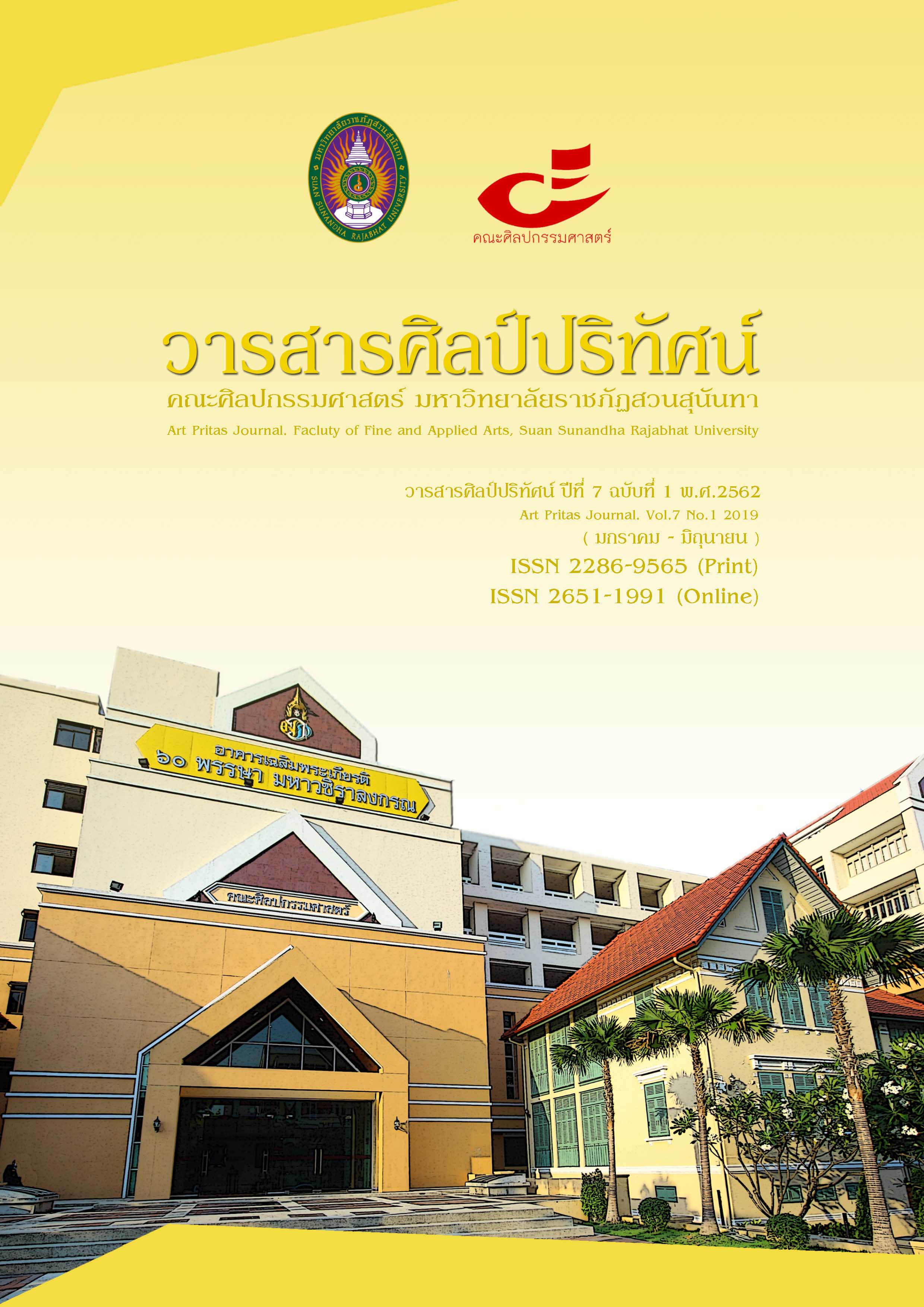นาฏยสร้างสรรค์ ชุด รวมใจอาเซียน
Main Article Content
บทคัดย่อ
การวิจัยนี้มีวัตถุประสงค์เพื่อสร้างสรรค์การแสดงนาฏศิลป์ชุด รวมใจอาเซียนที่ใช้ไม้ไผ่เป็นอุปกรณ์สำคัญในการสื่อถึงการรวมใจของประชาชาติอาเซียนทั้ง 10 ประเทศ จากการศึกษาเอกสาร การสัมภาษณ์ และการสังเกตการณ์การแสดงของนาฏศิลป์อาเซียนในรูปแบบการแสดงพื้นเมืองและนาฏศิลป์ที่มีความเป็นเอกลักษณ์เฉพาะที่ปรากฏในสื่อวีดิทัศน์ ผลการสร้างสรรค์การแสดงชุดนี้ ผู้วิจัยได้นำแนวคิดการผสมผสานความเป็นอาเซียน โดยออกแบบองค์ประกอบการแสดงที่สำคัญหลายด้าน ได้แก่ ด้านผู้แสดงจำนวน 10 คน เป็นชาย 4 คน หญิง 6 คน ด้านเครื่องแต่งกาย ได้นำผ้าที่เป็นเอกลักษณ์ของแต่ละประเทศมาสานเป็นผ้าสไบและผ้าคาดเอว ด้านเพลงใช้การผสมผสานเครื่องดนตรีตัวแทนทั้ง 10 ประเทศ โดยนายศุภฤกษ์ พุฒสโร เป็นผู้ประพันธ์เพลง ด้านการออกแบบท่ารำ ท่าเต้น สามารถแบ่งกลุ่มออกเป็น 3 กลุ่ม คือ 1. ท่ารำ ท่าเต้นที่ประยุกต์มาจากนาฏศิลป์แบบพื้นเมืองและแบบเอกลักษณ์เฉพาะของนาฏศิลป์ในอาเซียนทั้ง 10 ประเทศ โดยแบ่งออกเป็น 5 แบบ ได้แก่ แบบเหมือนนาฏศิลป์ไทย ได้แก่ ประเทศไทย กัมพูชา และลาว แบบนาฏศิลป์พม่า ได้แก่ ประเทศพม่า แบบเหมือนนาฏศิลป์มาเลเซีย ได้แก่ ประเทศมาเลเซีย อินโดนีเซีย และบรูไน แบบนาฏศิลป์อินเดีย ได้แก่ ประเทศสิงคโปร์ แบบนาฏศิลป์สเปนและนาฏศิลป์จีน ได้แก่ ประเทศฟิลิปปินส์ และเวียดนาม 2. ท่ารำ ท่าเต้นที่ได้มาจากการเลียนแบบท่าทางธรรมชาติ และท่ารำที่แสดงสัญลักษณ์ต่าง ๆ ได้แก่ ท่าไม้ไผ่ลู่ลม ท่าสายน้ำไหล ท่าเดินย่ำเท้าอย่างมีความสุข ท่าไม้ไผ่รวมกอ ท่าต้นไผ่กับอาเซียน ท่ารำเป็นกลุ่มของนักแสดงชาย - หญิง ท่ารำกระทบไม้ที่คิดขึ้นใหม่ 3. ท่ารำ ท่าเต้นที่ใช้ไม้ไผ่สร้างภาพวิถีชีวิตชาวอาเซียน ได้แก่ การนำไม้ไผ่มาประกอบเป็น บ้าน แพ ชิงช้า ซุ้มเครื่องเล่นไม้ไผ่ ซุ้มประตูไม้ไผ่ และกอไผ่รวมใจ โดยการแสดงแบ่งออกเป็น 3 ช่วง ช่วงที่ 1 นักแสดงอาเซียนออกมาจากม่านไม้ไผ่ด้วยความเป็นมิตร ช่วงที่ 2 การร่ายรำที่ผสมผสานความเป็นชาติอาเซียนทั้ง 10 ประเทศ และช่วงที่ 3 การละเล่นที่ใช้ไม้ไผ่และการรวมกันเป็นหนึ่งเดียวของชาวอาเซียน
Article Details
เนื้อหาและข้อมูลในบทความที่ลงตีพิมพ์ในวารสารศิลป์ปริทัศน์ ถือเป็นข้อคิดเห็นและความรับผิดชอบของผู้เขียนบทความโดยตรง ซึ่งกองบรรณาธิการวารสารไม่จำเป็นต้องเห็นด้วย หรือร่วมรับผิดชอบใดๆ
บทความ ข้อมูล เนื้อหา รูปภาพ ฯลฯ ที่ได้รับการตีพิมพ์ในวารสารศิลป์ปริทัศน์ถือเป็นลิขสิทธิ์ของวารสารศิลป์ปริทัศน์
เอกสารอ้างอิง
กองวัฒนธรรมสัมพันธ์กรมสารนิเทศ กระทรวงการต่างประเทศ. (ม.ป.ป.). ประเทศเพื่อนบ้านของไทย. กรุงเทพฯ: กระทรวง
การต่างประเทศ.
สุจิตต์ วงษ์เทศ. (2540). วัฒนธรรมไผ่ในอุษาคเนย์ฤาพรุ่งนี้เหลือเพียงตำนาน. ในกองบรรณาธิการ. (น. 82-90). กรุงเทพฯ: มหาวิทยาลัยธรรมศาสตร์.
สุรพล วิรุฬห์รักษ์. (2543). นาฏยศิลป์ปริทัศน์. จุฬาลงกรณ์มหาวิทยาลัย. กรุงเทพฯ.
Dransfield.S and Widjaja.E.A.. (2544). ทรัพยากรพืชในภูมิภาคเอเชียตะวันออกเฉียงใต้เล่มที่ 7: ไม้ไผ่ [Plant resources
of South-East Asia 7: Bamboos] (สุนทร ดุริยะประพันธ์, ผู้แปล). กรุงเทพฯ: สำนักงานคณะกรรมการวิจัย
แห่งชาติ.


